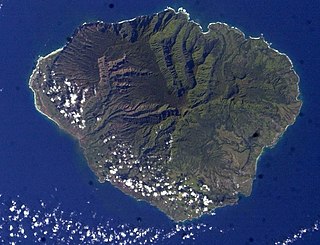
Kauaʻi, anglicized as Kauai, is geologically the second-oldest of the main Hawaiian Islands. With an area of 562.3 square miles (1,456.4 km2), it is the fourth-largest of these islands and the 21st largest island in the United States. Known also as the "Garden Isle", Kauaʻi lies 73 miles (117 km) across the Kauaʻi Channel, northwest of Oʻahu. This island is the site of Waimea Canyon State Park and the Na Pali Coast State Park.

Hawai'i is the largest island in the United States, located in the state of Hawaii. It is the southeasternmost of the Hawaiian Islands, a chain of volcanic islands in the North Pacific Ocean. With an area of 4,028 square miles (10,430 km2), it has 63% of the Hawaiian archipelago's combined landmass. However, it has only 13% of Hawaiʻi's population. The island of Hawaiʻi is the third largest island in Polynesia, behind the two main islands of New Zealand.
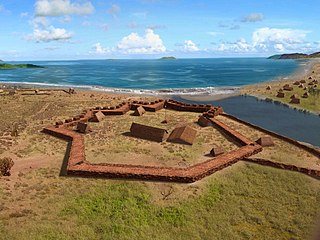
Russian Fort Elizabeth is a National Historic Landmark and is administered as the Russian Fort Elizabeth State Historical Park just southeast of present-day Waimea on the island of Kauaʻi in Hawaiʻi. It is located at the site of the former Fort Elizavety, the last remaining Russian fort on the Hawaiian islands, built in the early 19th century by the Russian-American Company as the result of an alliance with High Chief Kaumualiʻi. The star fort was employed by the Kingdom of Hawaii in the 19th century under the name Fort Hipo.
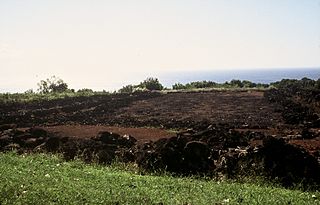
Puʻu o Mahuka Heiau State Historic Site on the North Shore of Oʻahu is the largest heiau on the island, covering 2 acres (8,100 m2) on a hilltop overlooking Waimea Bay and Waimea Valley. From its commanding heights, sentries could once monitor much of the northern shoreline of Oʻahu, and even spot signal fires from the Wailua Complex of Heiaus on Kauaʻi, with which it had ties. It was designated a National Historic Landmark in 1962, when it became the center of a 4-acre (16,000 m2) state park. It was added to the National Register of Historic Places in 1966.
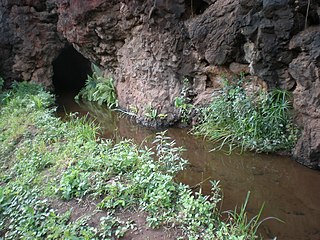
Kīkīaola is a historic irrigation ditch (ʻauwai) located near Waimea on the island of Kauai in the U.S. state of Hawaii. Also known as "Menehune Ditch" or "Peekauai Ditch," it was added to the National Register of Historic Places on November 16, 1984. It is purported to have been built by the Menehune.

The Cook Landing Site in Waimea on Kauaʻi island in Hawaii, is where Captain James Cook landed at the mouth of the Waimea River on January 20, 1778. Cook was the first European reported to have sighted the Hawaiian Islands, and the January 20 landfall on southwestern Kauaʻi was his first arrival upon Hawaiian soil. Cook Landing Site was registered as a National Historic Landmark on December 29, 1962. The landing is principally commemorated at Hofgaard Park, a small county park located near the supposed landing site.

Anna Ranch Heritage Center is a former cattle ranch in Waimea, Hawaii County, Hawaii named for Anna Leialoha Lindsey Perry-Fiske (1900–1995).
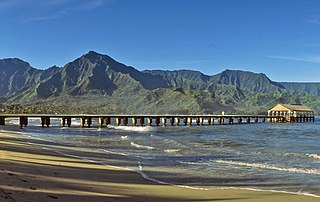
Hanalei Pier is a pier built into Hanalei Bay on the northern shore of the island of Kauaʻi in the state of Hawaii.
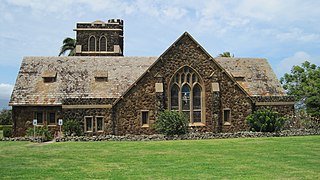
Makawao Union Church is a church near Makawao on the Hawaiian island of Maui. It was founded by New England missionary Jonathan Smith Green during the Kingdom of Hawaii. The third historic structure used by the congregation was designed by noted local architect C.W. Dickey and dedicated in 1917 as the Henry Perrine Baldwin Memorial Church. In 1985, Makawao Union Church was placed on the Hawaii and National Register of Historic Places.

The Waiʻoli Mission District at Hanalei Bay, on Route 560 along the north shore of the island of Kauaʻi, is the site of a historic mission. The first permanent missionaries to the area arrived in 1834, and the district was added to the National Register of Historic Places in 1973.

Peter Johnson Gulick was a missionary to the Kingdom of Hawaii and Japan. His descendants carried on the tradition of missionary work, and included several scientists.
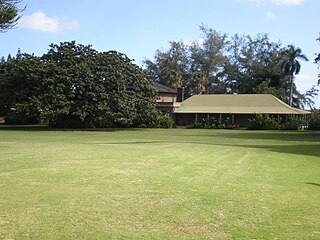
Grove Farm is a historic agricultural site on Kauai in the Hawaiian Islands.

The Albert Spencer Wilcox Building is a historic building in Līhuʻe, Kauaʻi, Hawaii. Originally a library when it opened in 1924, it was later converted into the Kauaʻi Museum. It has exhibits on the history of the island of Kauaʻi. It was added to both the Hawaiʻi Register of Historic Places and the National Register of Historic Places in 1979.

The Albert Spencer Wilcox Beach House was a home of Albert Spencer Wilcox. Located on Weke Road in Hanalei, Hawaii, it was listed on the Hawaiʻi Register of Historic Places in 1987 and on the National Register of Historic Places in 1993. It is a Folk Victorian-style building, with roofed lānai connecting the rooms. A 22-acre (8.9 ha) property, including five contributing buildings and four other contributing structures, was listed.
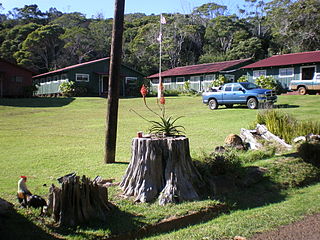
Civilian Conservation Corps Camp in Kokeʻe State Park is located at Hawaii Route 550, in Waimea, on the island of Kauai, in the U.S. state of Hawaii. It was built in 1935 with lumber that was put into the saltwater and floated to the shore at Port Allen, the seawater adding a natural termite protection to the lumber. The camp was in continual use for forest management, until Hurricane Iwa devastated it in 1982. In the 1990s it was restored through the efforts of the non-profit Hui O Laka environmental group, and is currently open to the public. It was added to the Hawaiʻi Register of Historic Places and the National Register of Historic Places on December 20, 1996.
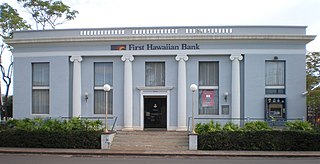
The Bishop National Bank of Hawaii was a bank in Hawaii. Its branch building on Hawaii Route 50 in Waimea, Kauai, Hawaii, was built in 1929. That branch building has also been known as First Hawaiian Bank, as Bishop National Bank, Waimea Branch, and as Bishop First National Bank, Waimea Branch. The building includes Classical Revival architecture and was a work of architect John Mason and of J.L. Young Engineering Co. The building was listed on the Hawaiʻi Register of Historic Places in 1977 and on the National Register of Historic Places (NRHP) in 1978.
The Charles Gay House, on Gay Road in Waimea, Kauai, Hawaii, was built in 1895. It has also been known as the Roland Gay Residence. It was listed on the Hawaiʻi Register of Historic Places and the National Register of Historic Places (NRHP) in 1984; the NRHP listing included three contributing buildings.

The Hanalei Elementary School, on Kuhio Highway in Hanalei, Hawaii, is a public elementary school of the Hawaii Department of Education. It formerly occupied a historic school building that was built in 1926. This building was listed on the Hawaiʻi Register of Historic Places in 1988 and on the National Register of Historic Places in 1990.

Camp Sloggett in Koke'e State Park near Kokee, Hawaii, is a historic site with significance from 1921. It is within state lands but has buildings owned by the Kauai Young Women's Christian Association.
The Haena Archeological Complex, on Kauai near Hanalei, Hawaii, is an archeological site complex that is listed on the U.S. National Register of Historic Places.




















